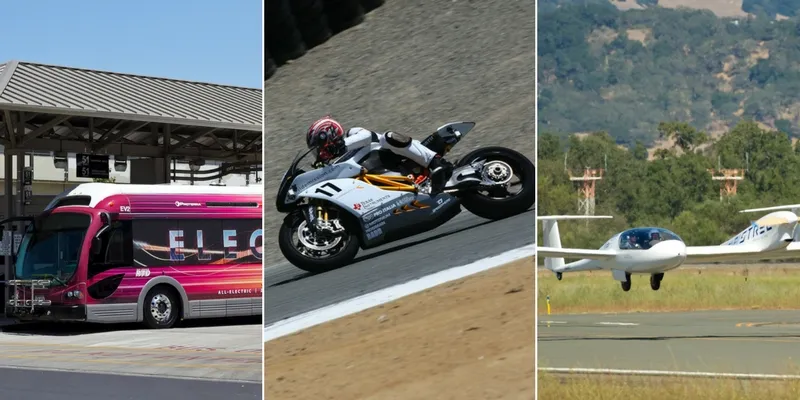How the electric vehicle revolution is moving beyond the world of cars
A few years ago, electric cars were viewed as nothing more than expensive toys. With long charging times, short travel ranges, and heavy batteries, they were hardly a practical alternative for their fossil fuel burning counterparts. But technology has evolved a great deal in the past few years and today, electric cars are rapidly taking over roads the world over.
Besides offering an eco-friendlier alternative to car commuters, the advancement of electric cars has also transformed a niche industry that was for the longest time dominated by those with the largest (and hence thirstiest) engines – supercars. Even luxury sedans and SUVs — such as Tesla’s Model S and Model X — boast of faster acceleration times than some of the world’s most prolific supercars, Ferraris and Lamborghinis included. Battery technology and energy recovery systems have evolved a great deal in the past five years or so. New companies such as Rimac, Vanda, Nio, and Genovation have joined in with stalwarts like Porsche, Aston Martin, and Tesla in creating the next generation of supercars.
While cars, thanks to their eye-watering top speeds and poster-worthy looks, are often the ones dominating headlines, they’re not the only mode of transportation currently undergoing a rEVolution. Here’s where the rest of the transportation industry stands in terms of going electric:

Planes
The chief problem faced by all-electric vehicles is that of energy storage. Since batteries have a much lower storage capacity of energy-per-unit-weight when compared to fossil fuels, they are required in large numbers for any feasible application in transportation, and hence add a lot of weight to the vehicle in question. While this may not be that much of an issue for, say, cars or buses, planes are a different story altogether. The energy required to power a commercial plane is colossal, and the need for reserve power in case of emergencies meant that, for a long while, electric engines were never a practical replacement for jet fuel. But many aeronautical companies, having started out with prototypes featuring hybrid engines, are closing in on all-electric planes.
The likes of Airbus, Boeing, and even NASA have, in association with startups like Zunum Aero and Wright Electric, developed several prototypes of wholly electric aeroplanes in the last year or so. Since then, however, electric planes have been limited to around 20-30 kW power outputs – a fraction of what it would take to power a modern-day commercial airliner. Hence, for now, several small aircraft, some of which can even carry a couple of passengers besides the pilot, are in development. A few companies, Airbus chief among them, have begun designing concepts of larger jets which will carry around 2 MW of energy on board. At the rate with which energy storage technology is advancing, it might take only a decade, or even lesser, for the first electric commercial jet to take flight.
Bikes
While electric two-wheelers have been around for years now, they were mostly all lightweight scooters in the past – they didn’t use much power, but couldn’t go very fast or very far either. But in the last decade or so, two-wheelers have undergone a revolution akin to their four-wheeled counterparts. The motorbike racing industry was catalysed when the legendary Isle of Man TT race inaugurated an electric-only segment way back in 2009. Since then, industry stalwarts like Honda and Yamaha have been joined by a host of newly founded companies in the performance bike industry.
The likes of Mission R, Lightning LS-218, Motoczysz E1pc, and Lito Sora have stormed onto the scene in much the same way as Tesla and Rimac in the car industry. Other sectors of the bike industry – such as commuter bikes, scooters, and dirt bikes – have also seen the entry of several promising new players. Companies like Zero Motorcycle, Luna Cycles, and India’s own Ather Energy and Tork Motorcycles are just some of the brands now manufacturing affordable and practical bikes powered by zero-emission engines.
Buses
An increased use of public transport, such as buses, has rightly been touted as an important step in combating the rise of vehicular pollution. But the effectiveness of such transport options has been undercut to a certain degree by their highly-polluting diesel engines. Today, however, a few manufacturers are combating this problem with buses that are run entirely on electric power. Hong Kong’s BYD, China’s Changsha Sunda New Energy Vehicles Technology, and India’s Tata Motors are just a few of the companies helping the world transition to an all-electric mode of public transportation.
In the city of Shenzhen, for example, all the 16,359 buses plying the roads are electric. Closer home, the government’s FAME (Faster Adoption and Manufacturing of Electric Vehicles) India project has helped drive down the prices of electric buses, thereby increasing adoption in the country’s biggest cities. Due to this initiative, we can expect to see several electric buses on the roads of cities like Bengaluru, Hyderabad, Delhi, and Mumbai within the next year.
Besides those mentioned above, there are several other transportation sectors being driven by electric power. Electric trucks, for instance, are steadily becoming more commonplace thanks to the efforts of companies like Workhorse, E-Force, Daimler, and BYD. The relatively recent announcement of Tesla’s Semi and the spawn of several new OEMs (Original Equipment Manufacturers) across the world has led certain analysts to predict that the electric truck market will record 2.25 million unit sales by 2025. Combining riderless vehicles Electric trains – which have been around for more than a century and a half – have, along with hybrid engines, almost entirely replaced locomotives powered solely by fossil fuels. From all this, it is evident that the complete conversion of nearly all transportation modes from fossil fuels to electric power is only a matter of time.







